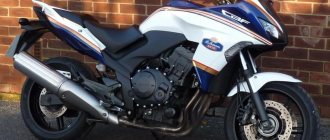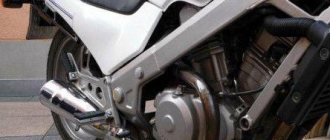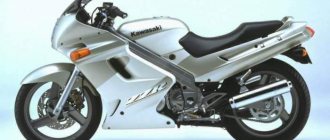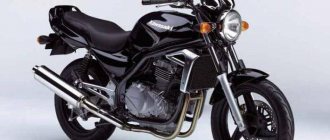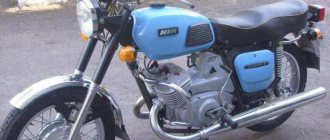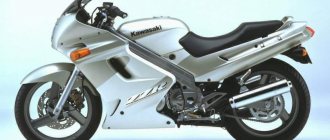- motorcycle model, Honda brand,
The Honda Hornet 250 road motorcycle model was first introduced in 1996 and was produced until 2007. The motorcycle also had a name - Honda CB 250 F. This model was based on an in-line 4-cylinder engine from the sports Honda CBR 250 RR, which was slightly retuned, but still produced a maximum power of 40 hp. at 14,000 rpm and spun up to 16,000 rpm. The frame, swingarm, fuel tank and wheels of the Honda Hornet 250 were taken from a 600cc Fireblade.
Other features of the Honda Hornet 250 include a steel frame, simple suspension in the form of a conventional telescopic monoshock fork (without progression) at the rear, a single-disc front brake, a 6-speed gearbox and a gear timing drive.
The Honda Hornet 250 was a domestic Japanese model and was not officially exported anywhere. The Honda Hornet 600 and Honda Hornet 900 models were offered to the foreign market.
The main competitors of the Honda Hornet 250 in the class:
Yamaha FZX 250 Zeal
Suzuki GSF 250 Bandit
Kawasaki Balius 250
Features and Review of Honda Hornet 250
The Hornet 250 motorcycle was created only for the Japanese domestic market and was not exported to other countries. Among the main features of the model, owners and experts noted a steel frame, a standard suspension represented by a telescopic rear fork with a monoshock absorber, a front single-disc brake mechanism, a gear timing drive and a six-speed transmission.
The main competitors of the Japanese motorcycle Honda Hornet 250 are considered to be classmates from the Land of the Rising Sun - Kawasaki Balius 250, Yamaha FZX 250 Zeal and Suzuki GSF 250 Bandit.
During the entire period of mass production of the model, from 1996 to 2007, the motorcycle was not subject to changes in the technical component. The main adjustments affected only the design of the bike and body colors.
Characteristics
New for 2008
– New black color
Motor/Drive Chain
The two-cylinder, 234cc SOHC engine is smooth, easy to control and produces decent power. Large cylinder fins for efficient engine cooling. Screw-type valve adjusters simplify operation. A single CV carburetor (26mm) offers high throttle response throughout the rev range. The CD ignition requires minimal maintenance. Low maintenance automatic cam chain tensioner. Beautiful and quiet chrome exhaust system. A simple, easily adjustable cable-operated clutch and an easy-to-shift five-speed gearbox. Durable drive chain.
Chassis/Suspension
– Steel frame – light and durable. The 31mm front forks offer a compliant, controlled ride. The dual rear shocks feature five-position preload adjustment to suit different loads and conditions. Powerful drum front and rear brakes. Lightweight spoked wheels with chrome rims. High-quality tires have excellent grip and a long service life.
additional characteristics
-The relaxed standard riding position and ergonomically designed saddle provide a high level of riding comfort for both rider and passenger. Large fuel tank capacity (4.3 gallons), renowned miles per gallon (mpg) and excellent mileage between fill-ups. Round halogen headlight. Low seat height, only 29.3 inches. Easy-to-read instrumentation on the instrument panel includes a convenient tripmeter. Convenient steering column lock for added security. Double mirrors. Low maintenance battery. Transferable, one-year, unlimited miles warranty; extended coverage under the Honda Protection Plan.
The purchase of a new, previously unregistered Honda USA-certified motorcycle by a single buyer in the United States provides the owner with a one-year complimentary membership in the Honda Club of America (HRCA).
Available accessories
-Tourist accessories: tank panel. Chrome accessories: back. Accessories: Motorcycle cover.
Engine
Combining simple and elegant design, signature Honda styling, a small engine and excellent performance, the Honda Hornet 250 is rightfully considered the ultimate classic SUV. The motorcycle is considered one of the best in its class, and deservedly so, as it is perfectly balanced, lightweight, compact and powerful. In terms of its characteristics and convenience, it is in no way inferior to the Honda CB400, everyone’s favorite.
The four-cylinder engine is built into a steel frame and features a liquid-cooling system, a modern six-speed transmission and carburetor feed. The price for the good parameters of a small-capacity engine is the need to rev it up: peak torque is achieved at 11 thousand revolutions, maximum power of 40 horsepower is at 14 thousand revolutions. Considering that the Honda Hornet 250 is a classic city bike, these figures are quite good.
Video
- A quick look and sound of the Honda Hornet 250 motorcycle
- A short test drive of the Honda Hornet 250 motorcycle
Honda Hornet CB 250 F
is a motorcycle intended for beginners that can pleasantly and carefully introduce a novice biker to the world of two-wheeled vehicles. However, the baby is surprisingly “muscular” and will be able to pleasantly surprise even an experienced motorcyclist. By the way, the Hornet 250 is also somewhat popular among experienced bikers, since it is inexpensive, consumes little gasoline, and has more than enough capabilities for everyday driving around the city. Except that you have to change gears more often than on some Honda CB 400 or Honda CB 750, but can this be considered a disadvantage?
The capabilities of the small-capacity Honda Hornet 250 are truly pleasantly surprising, as is this entire motorcycle as a whole. A classic road builder, slightly modernized in appearance, successfully combines good technical characteristics, simplicity and timeless style. Perhaps, in its class it can even be called one of the best, and this would not be an exaggeration. Moderately compact, lightweight, and powerful (by the standards of the class, of course), the Hornet 250 is a perfectly balanced city bike, which in terms of ease of everyday riding is in no way inferior to everyone’s favorite Honda CB 400.
A full-fledged 4-cylinder liquid-cooled engine is inserted into the steel frame, working with carburetors and a modern 6-speed transmission. The Honda Hornet 250 engine loves high speeds, and for dynamic driving it needs to be “twisted” - this is the price to pay for good parameters taken from a small-capacity engine. The Hornet 250 produces a torque of 24 nM at around 11,000 rpm, and maximum power of 40 forces at around 14,000 rpm. For an inexpensive urban classic with a quarter engine, these are excellent figures.
Despite the rather modest size of the Hornet 250, its ergonomics are excellent. A comfortable and relaxed driving position is guaranteed for a motorcyclist of almost any height, except perhaps very strong ones. The instruments, hidden in chrome “glasses,” are perfectly legible, and all controls are located in the usual places. The dry weight of the Hornet 250 is only about one hundred and fifty kilograms.
The motorcycle's suspension design is classic, with a telescopic fork at the front and one monoshock absorber at the rear. It can confidently be called comfortable, however, if there is a passenger, the motorcycle noticeably “sags”. After all, the Honda Hornet 250 is designed primarily for driving alone, although no one forbids taking a passenger to their destination if necessary, of course. By the way, you will rarely have to refuel along the way - the average consumption of the Hornet 250 is about 4 liters per hundred, and the volume of the gas tank is as much as 16 liters. The brakes deserve attention, and attention in every sense. There is one brake disc on both the front and rear wheels of the Hornet 250, and the motorcycle brakes very effectively. Moreover, you have to be very careful with the front brake - it is so grippy that you can overdo it. But there is no doubt that in an emergency, the Hornet 250's capabilities are enough to stop quickly.
The 250cc Hornet is definitely one of the best in its class. Small, light, great to handle, it accelerates in a way you wouldn't expect from it. True, after 120 km/h the engine runs out of steam, and to maintain dynamics in city driving you have to change gears frequently, but this certainly doesn’t make the Honda Hornet 250 any worse.
Ergonomics and ride quality
The compact dimensions of the Hornet 250 do not in any way affect its ergonomics: a convenient and comfortable fit is provided even for tall motorcyclists. The motorcycle’s instruments are highly informative and hidden in chrome “glasses”; the main controls are located at hand. The curb weight stated in the technical specifications of the Honda Hornert 250 is 150 kilograms.
The suspension design is classic, represented by a rear monoshock absorber and a front telescopic fork. When there is a passenger, the motorcycle sags noticeably, but this does not affect the suspension parameters - it perfectly conceals road unevenness. The Hornet 250 is not designed to carry a passenger, but this does not prevent it from carrying a second person over considerable distances.
The 16-liter fuel tank provides good autonomy for the motorcycle and allows you to cover long distances without refueling. The braking system is made up of disc mechanisms and is highly effective, but the front disc is too grippy, so you need to control it when stopping. The braking system allows you to quickly stop the motorcycle even at high speed.
005_moto_0411_030
Three-piston calipers are installed on the version with ABS, but only the outer pistons “work” from the lever on the steering wheel. The central one is operated by a pedal. In general, the braking system lacks information content, especially on the lever. Traditionally, for roadster and sports cars, the rear brake is ineffective. Three-piston calipers are installed on the version with ABS, but only the outer pistons “work” from the lever on the steering wheel. The central one is operated by a pedal. In general, the braking system lacks information content, especially on the lever. Traditionally, for roadster and sports cars, the rear brake is ineffective.
Honda Hornet 250 reviews
For its compact dimensions, the Hornet 250 is equipped with fairly large tires: 120 tires are installed on the front, 180 tires on the rear. The engine installed on the motorcycle, with a displacement of 250 cubic centimeters and a power of 40 horsepower, is distinguished by its small size thanks to cylinders with a stroke of 48 millimeters. The sleek frame and compact powertrain make the Honda Hornet 250 look sleek and slim. The dashboard is largely the same as on roadsters.
The engine choke is located on the handlebar; with sufficient throttle control, you can start the motorcycle at any time of the year. Engine operation is uniform throughout the entire speed range, without extraneous noise and vibrations characteristic of situations with increased power and traction. The engine oil level is controlled by a special dipstick. The Honda Hornet 250's cable-actuated clutch is quite light and soft. The six-speed transmission provides crisp, precise shifting.
The maximum speed developed by the motorcycle is 201 km/h - an excellent indicator for this class of cars. The Hornet easily takes sharp turns at high speed and obediently responds to the pilot’s commands on any road surface. The braking system and suspensions are reliable and highly efficient.
Excellent handling and clear motorcycle-driver communication are the undeniable advantages of the Honda Hornet 250, indicated in owner reviews. The dashboard is ergonomic, all controls are at hand. The energy-saving suspension and seat height are ideal for pilots weighing 90 kilograms. Although the passenger seat is a little high, it provides a comfortable and comfortable seating position.
The braking system of the Japanese motorcycle is disc type, equipped with a four-piston shock absorber at the front and provides excellent and fast deceleration. The brakes are highly effective even on slippery and wet road surfaces. Hornet 250 has excellent autonomy: with a consumption of six liters per 100 kilometers, it can travel 250 kilometers without refueling.
When 300 “cubes” is better than a liter. Honda CB300R Neo Sports Caffe test
I'm testing last year's new product - the Honda CB300R Neo Sports Caffe. This is the youngest and most affordable of the three models of the Neo Sports Caffe family. Outwardly they are very similar: it seems that many parts are interchangeable.
In the design of motorcycles, there is an automotive tendency towards uniformity of appearance across the entire line of models.
The assembly and appearance of the Honda CB300R are of Japanese quality, although the motorcycle is produced in Thailand. I've been to those parts and I can say that such a 300 cc Honda in Southeast Asia is considered luxury with excess power. For us, an engine with a volume of 286 cubic meters, producing 31 horsepower, is for “first-season drivers” at best.
I was pleased with the gearbox, namely the precision with which Honda engineers selected the gear ratios. The engine and gearbox work for performance and, when accelerating, allow the motorcycle to accelerate as efficiently as possible. Cooperation with suspension manufacturer Showa can also be called successful. The motorcycle performs well in urban conditions, vigorously diving between the rows. On a country road, the suspensions are not annoying with their rigidity and eat up most of the bumps, which has a beneficial effect on the health and mood of the rider.
I would like to write about the brakes very simply - they exist, and they have ABS. They can’t do anything supernatural, and it’s not required of them. Let it be this: the braking force is enough to stop predictably.
If I said that the Honda CB300R is a pleasure to ride, you might think I was lying, and you wouldn't be far from the truth. In defense of this little beast, I will note that it is very convenient in the city. It is the smallest in its class, which means you can get through cracks that competitors can’t even think of.
On a long trip I liked the work of the suspension, everything was clear and moderately rigid. If you don’t rev the engine too loud, you’ll be pleasantly surprised by the fuel consumption – at a speed of about 100 km/h the motorcycle consumes some drops.
If we compare the CB300R with its competitors, the Honda looks nicer and more modern than the rest. But it is inferior to all classmates in dynamics. But, most likely, the CB300R motor has a longer service life. And again, “but” - Honda is much more expensive than its classmates. If you want to stand out, feel free to buy a CB300R - and all owners of classmate motorcycles will look at you with envy, knowing that your motorcycle is the most expensive.
| Dimensions (length/height/saddle height) | 2012x802x799 mm |
| Base | 1352 mm |
| Fuel tank volume) | 10 l |
| Engine | 286 cm3, 1‑cylinder, 4‑stroke, liquid cooling, 31 l. s., 27.5 Nm |
| Transmission | mech., 6-speed, drive - chain |
| Suspension (front/rear) | 41mm Showa inverted fork, 130mm travel / Pro-Link progressive monoshock and swingarm, 107mm travel |
| Brake (front/rear) | Radial 4-piston Nissin caliper, 1 floating disc 296 mm / 1 disc with 1-piston caliper Ø 220 mm |
| Curb weight | 143 kg |
| Technologies | ABS, diode optics |
- Honda CB300R
- Test Drive
News Media2
Summary
Hornet 250, equipped with a 250 cc engine, has rightfully earned the title of one of the best motorcycles in its class thanks to its excellent acceleration dynamics, chic handling, compactness and convenience. The only thing that causes criticism is the difficulty in finding spare parts for the motorcycle, a decrease in traction after breaking the speed barrier of 120 km/h and the need to regularly change gears to maintain dynamics in urban operation, which, however, does not spoil the brainchild of the Japanese company.
